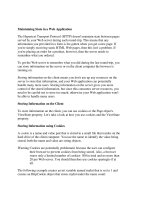Tài liệu Mental Health in a Multi-ethnic Society A Multi-disciplinary Handbook docx
Bạn đang xem bản rút gọn của tài liệu. Xem và tải ngay bản đầy đủ của tài liệu tại đây (1.42 MB, 250 trang )
Mental Health in a Multi-ethnic Society
As services in the community continue to replace institution-based
care there is an increasing need for professionals from medical, social
work, clinical psychology, nursing and other backgrounds to address
the diverse needs of a multi-ethnic society using a common frame of
reference. Those who provide mental health services must now face
up to challenges from service users and strive for a closer, more
effective working relationship with voluntary organisations. Mental
Health in a Multi-ethnic Society: A Multi-disciplinary Handbook
addresses all these issues. It offers an approach to the meaning of
mental health and suggests constructive and imaginative ways of
providing care for people with mental health problems.
Contributions from a multi-ethnic team of professionals are
organised in three parts: ‘Current setting’ describes the background
to contemporary mental health services, the legal framework and
the role of the voluntary sector, and examines the experience of black
people. ‘Confronting issues’ considers practical problems in delivering
services to a multi-ethnic society and offers some innovative
approaches. The final part, ‘Seeking change’, draws together the
various issues in order to indicate a way forward, with suggestions
for change on both a practical and theoretical level.
Intended primarily as a handbook for practitioners working in
the mental health field, it is also suitable for multi-disciplinary
trainings, basic trainings and in-service postgraduate trainings in a
variety of professions including social work, psychology, psychiatry
and nursing.
Suman Fernando is a Senior Lecturer in Mental Health at the Tizard
Centre, University of Kent at Canterbury, and Honorary Consultant
Psychiatrist at Enfield Community Care Trust, Middlesex.
Mental Health in a
Multi-ethnic Society
A Multi-disciplinary Handbook
Edited by Suman Fernando
London and New York
First published 1995
by Routledge
11 New Fetter Lane, London EC4P 4EE
This edition published in the Taylor & Francis e-Library, 2006.
To purchase your own copy of this or any of Taylor & Francis or
Routledge’s collection of thousands of eBooks please go to
www.eBookstore.tandf.co.uk.
Simultaneously published in the USA and Canada
by Routledge
29 West 35th Street, New York, NY 10001
© 1995 Suman Fernando, the edited collection; individual
contributions © 1995 the contributors
All rights reserved. No part of this book may be reprinted
or reproduced or utilised in any form or by any electronic,
mechanical, or other means, now known or hereafter
invented, including photocopying and recording, or in any
information storage or retrieval system, without permission
in writing from the publishers.
British Library Cataloguing in Publication Data
A catalogue record for this book is available from the British
Library
Library of Congress Cataloging in Publication Data
A catalog record for this book is available from the Library
of Congress
ISBN 0-203-13459-1 Master e-book ISBN
ISBN 0-203-18559-5 (Adobe eReader Format)
ISBN 0-415-10536-6 (hbk)
ISBN 0-415-10537-4 (pbk)
To all those who meet racism or cultural
intolerance in the field of mental health.
Contents
List of illustrations x
Notes on contributors xi
Acknowledgements xiv
Introduction 1
Part I Current setting
1 Social realities and mental health 11
Suman Fernando
Psychiatric thinking in the context of culture and race 12
Recent history of service provision 18
Racism, multiculturalism and stereotypes 23
Models of mental health 30
Discrimination, diagnosis and ‘treatment’ 32
Summary 34
2 Professional interventions: therapy and care 36
Suman Fernando
Historical perspective 37
Treatment, self-help and need 44
Conclusions 49
3 Law and guidelines 50
William Bingley
The law and services 51
Protecting ‘vulnerable’ people 55
Compulsory admission and treatment 57
Conclusions 61
4 Sectioning: the black experience 62
Deryck Browne
viii Contents
Civil sections 63
Forensic sections 68
Discussion 71
5 Voluntary groups 73
Tanzeem Ahmed and Amanda Webb-Johnson
Background 74
Voluntary groups and mental health 75
Perceptions of users of services 76
Asian voluntary sector 78
Conclusions 83
Part II Confronting issues
6 Consulting and empowering Black mental health system
users 89
Mina Sassoon and Vivien Lindow
Introduction 90
Voices of the silenced: experiences of Black users 90
The validation of the user view 93
The emergence of a psychiatric system survivor movement 94
Relationship between Black service users and the mental
health service user movement 98
Black empowerment models 102
Black user projects 103
Conclusions 104
Some addresses 105
7 Training to promote race equality 107
Peter Ferns and Mita Madden
Defining race equality training 108
Context of race equality training 110
Race equality training programmes 112
Evaluation and follow up 115
Checklist for training courses 115
Implications of training for organisational development 117
Conclusions 119
8 Reaching out 120
Parimala Moodley
Counteracting racism 121
Outreach in the community 126
Contents ix
9 Interaction in women’s mental health and
neighbourhood development 139
Sue Holland
Four steps in social action psychotherapy 140
Emergent issues 142
Women’s Action for Mental Health (WAMH) 143
From ‘fringe’ to ‘mainstream’ 143
10 Culture and family therapy 148
Inga-Britt Krause and Ann C.Miller
Themes in cross-cultural therapy 150
A framework for ‘good enough’ cross-cultural
understanding 155
Cross-cultural practice: developing a community-based
service 156
Summary 170
Acknowledgements 170
Notes 171
11 Psychotherapy in the context of race and culture: an
inter-cultural therapeutic approach 172
Lennox Thomas
Race and culture in the consulting room 173
Case study 1 177
Case study 2 178
Experiences at Nafsiyat 179
Part III Seeking change
12 The way forward 193
Suman Fernando
A new meaning of mental health 196
A multi-systemic approach to assessment 199
Therapy: the interventions of professional workers 204
Understanding culture 205
Anti-racist measures 208
Needs assessment 209
Strategies for service provision 211
Conclusions 212
Further reading 215
References 217
Subject index 228
Name index 233
Illustrations
Figure 1.1 Culture of psychiatry 13
Figure 1.2 The psychiatric process 15
Figure 1.3 Ideals of mental health 18
Figure 1.4 Racial and cultural issues: British findings 34
Figure 2.1 Treatment/liberation East and West 44
Figure 7.1 Model for race equality training 107
Figure 7.2 The process and outcome of race equality
training 110
Figure 8.1 The patient and the institution 122
Figure 9.1 Theoretical positions in moving from personal
symptom to public action 141
Figure 10.1 A model for the development of a community
family counselling service 162
Figure 10.2 Different constructions of Salma’s behaviour 165
Figure 11.1 White therapist and Black child: initial position 188
Figure 11.2 White therapist and Black child: intermediate
position 189
Figure 11.3 White therapist and Black child: ultimate
position 190
Figure 12.1 Traditional psychiatric assessment 200
Figure 12.2 Relativist multi-systemic assessment 202
Contributors
Tanzeem Ahmed. Tanzeem is a psychologist with a background in
‘child guidance’ and research into cognitive development of children.
Currently, Tanzeem is the Director of Confederation of Indian
Organisations and she has managed three research projects in the
field of community mental health focusing on individual experiences
and voluntary organisations.
William Bingley. A lawyer by training, William was Legal Director
of the National Association for Mental Health (MIND) for six
years in the 1980s before becoming the Executive Secretary of
the working group that prepared the Mental Health Act Code of
Practice. In 1990, he was appointed the first Chief Executive of
the Mental Health Act Commission, a position which he still
holds.
Deryck Browne. Deryck is Policy Development Officer with the
National Association for the Care and Resettlement of Offenders
(NACRO). With a background of African-American studies and
forensic behavioural science, Deryck has researched the psychiatric
remand process as it affects black defendants and, more recently,
the impact of race on civil detention (‘sectioning’) under the Mental
Health Act 1983.
Suman Fernando. A consultant psychiatrist and former Mental
Health Act Commissioner, Suman is involved in consultancy, training
and research in the mental health field. He is Chair of the Board of
Directors of Nafsiyat (Inter-cultural Therapy Centre) and a member
of the Council of Management of MIND. Suman has written two
books, Race and Culture in Psychiatry (Routledge, 1988) and Mental
Health, Race and Culture (Macmillan/MIND, 1991).
xii Contributors
Peter Ferns. Peter is a qualified social worker with experience of
services for people with learning difficulties and of mental health
services. He has a wide experience of consultancy in both the
statutory and voluntary sectors, specialising in community care and
issues involving race. Peter has been involved in the training of
professionals in the mental health field for many years.
Sue Holland. Sue has pioneered ‘social action psychotherapy’ services
in working-class multi-racial London neighbourhoods for 20 years.
Currently, she is a consultant clinical psychologist with South
Buckinghamshire NHS Trust, working specifically with Black and
Asian minorities. Recently, Sue was given the newly established
Award for Challenging Inequality of Opportunity by the British
Psychological Society (BPS).
Inga-Britt Krause. Britt is a family therapist at the Marlborough
Family Service in London, and a tutor on the Diploma Course in
Inter-cultural Therapy at University College. With Ann Miller, she is
involved in the Asian Families Community Project based at the
Marlborough. Britt is an anthropologist who has worked in a Hindu
community in the Himalayas and with Punjabis settled in Britain.
Vivien Lindow. Vivien is an independent consultant, researcher and
writer in the field of user involvement in mental health services. She
is an active member of the psychiatric system survivor movement,
including ‘Survivors Speak Out’, and is involved in the training of
professionals working in the mental health field. Vivien is an elected
member of the Council of Management of MIND.
Mita Madden. Following extensive experience in social work,
Mita has been involved in training in the mental health field for
many years, with a special interest in anti-racist/discriminatory
practice and in user/carer empowerment issues. Currently, she is
Training Officer, Social Services Department, London Borough
of Harrow.
Ann C.Miller. Ann, a family therapist, is Principal Clinical
Psychologist at the Marlborough Family Service. With Britt Krause,
she is involved in the Asian Families Community Project based at
the Marlborough. She is director of the joint Malborough/University
College London Diploma in Family Therapy which has developed
teaching in relation to racism and culture. Ann also teaches at the
Institute of Family Therapy in London.
Contributors xiii
Parimala Moodley. In the 1980s Parimala set up a unique service in
Camberwell—the Maudsley Outreach Service Team (MOST), for
outreach work with (mainly) black clients with mental health
problems living in the community. She is now a consultant
psychiatrist in South London and also Chair of the Transcultural
Psychiatry Society (UK) and the Transcultural Interest Group within
the Royal College of Psychiatrists.
Mina Sassoon. Mina has extensive experience of working with user
groups and ethnic minority communities while working in the
voluntary sector, including local MIND Associations and Good
Practices in Mental Health (GPMH). Currently, she is Training
Officer in Mental Health and Ethnicity for North West London NHS
Trust.
Lennox Thomas. Lennox is the Clinical Director of Nafsiyat
(Intercultural Therapy Centre) and joint Course Director of the
Diploma in Intercultural Therapy at University College, London.
With a background in psychiatric social work and probation before
training in psychoanalytic psychotherapy, Lennox works as an
individual and family therapist with an interest in the psychological
development of the Black child.
Amanda Webb-Johnson. As a primary school teacher, Amanda had
an interest in multicultural and anti-racist education and spent a
year in India researching the education of children. Later, while
working at the Confederation of Indian Organisations, Amanda
carried out the research for the reports A Cry for Change
(Confederation of Indian Organisations, 1991) and Building on
Strengths (Confederation of Indian Organisations, 1993). Amanda
is a trained counsellor and also works at Voluntary Services
Overseas.
Acknowledgements
Although the views expressed in each chapter are those of the
author(s) concerned, they have been influenced by many colleagues
and friends in various organisations and settings, in particular the
Transcultural Psychiatry Society (UK); Survivors Speak Out; Nafsiyat
(Intercultural Therapy Centre); MIND; the Marlborough Family
Service; Good Practices in Mental Health; Clinical Psychology, Race
and Culture Special Interest Group of the British Psychological
Society and the confederation of Indian Organisations. In addition,
the editor acknowledges the encouragement and help of numerous
people in the field of mental health.
The extract from the video ‘From anger to action’ is published
with the permission of Mental Health Media. The extract from ‘Still
I rise’ in And Still I Rise by Maya Angelou copyright © 1978 by
Maya Angelou is reprinted by kind permission of the publishers,
Virago Press and Random House, New York. The extract from
‘Untitled’ in Survivors’ Poetry: From dark to light is reprinted by
kind permission of Premila Trivedi.
Introduction
Suman Fernando
The change in emphasis from institution-based psychiatry to mental
health care based in the community is affecting services across Europe
and North America, and involves a change in ways of thinking about
health and illness. Essentially it means a shift from ‘symptoms-
thinking’ to ‘needs-thinking’, from looking for illness to promoting
health. This transformation is foreshadowed in changes in the
language used in many circles and attempts to look anew at the
ideologies and concepts that inform the development of services as
indicated in recent policy documents (MIND, 1993a, 1993b) and
papers (Cobb, 1993; Wood, 1993; Darton et al., 1994) issued by
the National Association for Mental Health (MIND). The term
‘mental health problem’ has replaced, to some extent, ‘mental illness’;
people formerly called ‘patients’ are increasingly referred to as ‘service
users’; and rather than (psychiatric) treatments, ‘interventions’ are
planned—with the totality being subsumed within the concept of
promoting ‘mental health care’, not the eradication of ‘mental illness’.
There is much more talk about services based on needs-assessment
(rather than diagnosis), and multi-disciplinary community teams are
being seen as the basis of mental health services, with the (medical)
general practitioner and hospital-based psychiatrist being one of a
team and not necessarily its leader. The government’s White Paper
Caring for People (DHSS, 1993) sees the assessment of need as a
‘cornerstone of community care’. In the midst of all this, one hears
and reads about the need to address the diversity of need in a
multicultural society, and about the inequities caused by racism.
Although community care is envisaged as the foundation, there
is little doubt that hospital care is to continue as an important part
of the total mental health service. However, the exact balance between
hospital care and community care within a mental health service is
2 Mental Health in a Multi-ethnic Society
extremely uncertain, and is likely to depend on many legal, social
and political factors. First, as the law stands at present, compulsory
treatment (under provisions of the Mental Health Act 1983) cannot
be given unless a person is an in-patient of a hospital. Second, the
extent to which community services are likely to be able to provide
sufficient care—within the resource limits set by the availability of
funding, voluntary commitment, etc.—to enable community care to
cater for people with all types of mental health problems, including
those who have developed dependency because of institutionalisation
(the ‘long stay’) as well as those being identified (by psychiatry) as
‘the new long stay’, is not clear. Third, and most importantly, the
intolerance of deviancy by society at large may compel mental health
services (politically or through force of circumstances) to continue,
at least to some extent, its traditional function of ‘putting away’
people unwanted by society.
This is a book for professionals working in the mental health
field and for those who are training to do so. It is not geared to any
particular professional group. Indeed the book was conceived as a
common text for all professional groups working (or training to
work) in the statutory services—that is, those services under the
direction of Social Service Departments and Hospital Trusts operating
under the National Health Service. The editor and several of the
authors who have contributed to this text have experienced recent
changes in management structures within Health and Social Services
as a result of changes in the organisation of responsibilities between
Health and Local Authority enunciated in the Community Care Act
1990—changes which clearly influence the framework in which
professionals work. However, we feel that on the whole, professional
workers at the grass roots, although influenced by changes in
management structures, to a great extent carry on regardless.
Therefore, this book does not seek to evaluate or discuss the changes
resulting from new structures in Social Services and the National
Health Service, except in referring to their impact on professional
practices when necessary—especially in the last chapter, when the
future prospects for mental health services are considered.
Many of the ‘mission statements’ of Hospital Trusts, and policies
enunciated by Social Service Departments reflect the change in
orientation of mental health services from being predominantly
hospital-based to being mainly based in the community. The aims of
the services are usually articulated in terms of meeting mental health
needs. However, relatively little attention has been given to a crucial
Introduction 3
issue, namely the training of professionals who are supposed to run
such mental health services. Nor has there been much consideration
of theoretical issues that would inform such training. At present,
multi-disciplinary work is often disjointed because of wide divisions
between the ideologies of different professional groups and the lack
of adequate training schemes to bring professionals together. There
is little agreement about fundamental issues such as working concepts
of ‘mental health’ or ‘needs’, between, on the one hand, the (hospital-
based or ex-hospital-based) psychiatric personnel—mainly
psychiatrists—and, on the other, socio-culturally inclined mental
health workers—including many trans-cultural psychiatrists. A recent
publication by the former group Measuring Mental Health Needs
(Thornicroft et al., 1992) sees ‘needs’ in terms of illness models
requiring treatment. But as community care replaces institutional
models of practice, cross-disciplinary training must emerge. A
common frame of reference, at least on basic issues, must evolve—
or be manufactured—and for this to happen a common text is
essential. Unfortunately there is (at present) no publication that could
be described as a comprehensive text or handbook suitable for all
disciplines working in mental health services. The aim of this book
is to redress this deficiency while focusing on the multicultural nature
of society that the services are supposed to benefit.
The culture of training in all the professions involved in mental
health care has been, up to now, one based primarily on considering
mental health problems in terms of ‘illness’. Therefore, however much
we try to modify our ‘illness-based’ attitude to the meaning of ‘health’
or move away from it, the natural—almost the normal—tendency
in all professional work is to think of health as the converse of illness.
Moreover, whenever there is pressure on a professional to explain
some serious problem or to account for some seemingly unreasonable
behaviour on the part of a fellow being, the tendency is to fall back
on some sort of variation of the illness model. Thus, when there is
publicity about some mishap affecting someone who has the ‘mental
illness’ label, the main discussion centres on the extent of ‘illness’—
as if ‘illness’ is something that can be clearly defined. A recent example
is that of the tragedy involving Christopher Clunis, resulting in
recommendations that concentrate on ways of ‘treating’ the ‘illness’
early (Ritchie et al., 1994), with no reference to service provision
based on ‘needs assessment’ but a deference to the traditional
‘treatment of illness’ approach. In many of these situations, there is
also often a tendency to make assumptions without too much
4 Mental Health in a Multi-ethnic Society
thought—assumptions that are often no more than a reflection of
popular (and inaccurate) stereotyping.
In recent years, both psychiatry and clinical psychology have
been subject to criticism that has attracted much attention. The
concepts of illness and therapy have been attacked from within
the professions themselves—for example, in The Manufacture of
Madness by Thomas Szasz (1969), Against Therapy by Jeffrey
Masson (1988) and Toxic Psychiatry by Peter Breggin (1991).
However, this criticism has had very little impact on day-to-day
hospital-based services or on many of the changes that have taken
place in the move from institutional to community care. MIND’s
policy documents lack the rhetoric of Szasz, Masson and Breggin
but express the dissatisfaction heard on the ground and voiced
increasingly strongly by service users. Basically, the pressure is for
the disciplines that provide mental health services to become
sensitive to social issues, such as sexism and racism, to user
involvement and to the real needs of people in trouble. Some
professionals have taken up these calls (e.g. Howitt, 1991;
Fernando, 1991), but the extent to which they have affected the
training of professionals has been negligible.
A major problem in the training of professionals for mental health
work has been the lack of an overall approach that encompasses, as
a totality, the various facets of a modern Western society—relating
these to concepts of mental health and interventions designed to
maintain such ‘health’. Such an approach needs to be informed by
clear analyses of social realities (of society), the traditions, and indeed
history, of the professional groups involved, the place of voluntary
organisations and finally (and perhaps most importantly), the
perceptions and views of the users of the services. This book is an
attempt to redress this imbalance.
Nothing in the field of mental health can possibly be explored in
a social vacuum—not problems, ‘illness’, health, interventions, legal
issues nor indeed anything else that has a bearing on mental health
care. And one of the significant social issues of our time is racism, so
that it is inevitable that racism is a part of the scene in most, if not
all, of the chapters in this book. Unfortunately considerable confusion
exists between what is ‘racial’ and what is ‘cultural’, and this has
played a not insignificant part in allowing ‘cultural racism’ (also
called the ‘new racism’) to replace ‘biological racism’ (Barker, 1981;
Gilroy, 1987; Husband, 1994). The concept of ‘ethnicity’ appears
to get over this problem—but does it? In fact, the terms race, culture
Introduction 5
and ethnicity (and their derivatives) are often used rather loosely,
almost interchangeably. The usual meanings and uses of these terms
have been discussed fully elsewhere (e.g. Fernando, 1991) and will
be summarised here.
The word ‘culture’ denotes a way of life (family life, patterns of
behaviour and belief, language, etc.), but it is important to note that
cultures are not static, especially in a community where there are
people from several cultures living side by side. Reference to race
does not necessarily imply support for the thesis that people are
inherently ‘different’ because of certain inherited characteristics that
are related to skin colour, but it does imply that people are treated
differently because of skin colour—that the concept of race is a social
reality. The term ‘ethnic’ generally refers to a sense of belonging
based on both culture and race and is used sometimes when the
term ‘culture’ or ‘race’ is inappropriate or undesirable for various
reasons. Although there is no consistent way in which the term ‘black’
is used to describe people, it may be used in what is called a ‘political
sense’—to refer to people identified not just by the colour of their
skin but more generally as those who trace their ancestry to
populations that were and/or are subjugated and exploited, etc. by
people who are known as ‘white people’.
The title of this book refers to a ‘multi-ethnic’ society, a term
which encompasses both the racial and cultural identities of the
people who constitute British society. However, sometimes this society
is referred to as ‘multicultural’ or ‘multiracial’ if either ‘culture’ or
‘race’ is being emphasised—in keeping with the discussion in the
previous paragraph (the hyphen being dropped to indicate the unity
implied in the words). Similarly, other words referring to race, culture
and ethnicity are used as appropriate to the context. Each author
has tried to steer a way through somewhat variable understandings
of the concepts of race, culture and ethnicity. Since they are from
diverse professional backgrounds in both the voluntary and statutory
sectors, their approaches to questions of race and culture vary and
their perceptions of the meaning of mental health are not always
identical. As a result, some authors use the capital ‘B’ or ‘W’ in
designating people’s race based on skin colour, while others do not
do so; some authors refer to ‘patients’, others to ‘clients’ and still
others to ‘service users’. The editor has not attempted to introduce
uniformity of terminology across chapters but the meanings of terms
and use of words are usually consistent within each chapter. The
diversity of views, styles and fashions points to the fact that there
6 Mental Health in a Multi-ethnic Society
are no easy answers to many questions in the field of mental health—
nor to issues concerning race and culture. Ultimately, professionals
need to think for themselves and that is essentially what training is
all about.
The first part of the book deals with the context in which mental
health services operate—its ‘Current setting’. The second part,
‘Confronting issues’, addresses racial and cultural issues that arise
in delivering these services in a multi-ethnic society. Finally in the
third part, ‘Seeking change’, the various issues are brought together
in order to indicate a way forward—not so much a ‘blueprint’ for
the future as suggestions for change, starting from where we are
now. All the chapters are informed by an awareness of the cultural
diversity of British society, the realities of racism and the importance
of social issues both in general and within the professions that
control the mental health scene.
The training of mental health workers, and indeed the practice of
professionals in the mental health field, must first and foremost
address the question: ‘What is mental health?’. Even more pertinently,
it must address the issue of what mental health means in a multi-
ethnic setting in terms of the practical politics of service provision.
Although the definition of mental health must be built on an
appreciation of contemporary social realities (with respect to
questions of illness and health, issues of race and culture, etc.), it is
not just a theoretical, academic definition of ‘mental health’ that is
required, but an evaluation of what mental health actually means as
a practical proposition.
Chapter 1 examines Western thinking about mental health and
illness in a historical context, considers the concept of
multiculturalism in the presence of racism and finally analyses the
meaning of mental health in the light of discriminatory diagnostic
practices. In Chapter 2, the question of ‘therapy’ is faced. After a
general discussion of its meaning across cultures seen in a historical
context, the chapter explores the seemingly mystical element in what
goes for therapy and the dimensions of power in the interaction
between professionals and service users.
Mental health services, like all other services, are provided within
a legal framework. Chapter 3 analyses the main laws which constitute
this legal framework, referring also to guidelines on practice issued
by the Department of Health and to ways in which mental health
legislation could change in the future. Chapter 4 examines in some
depth—based on research carried out by the author—the experience
Introduction 7
of black people in their confrontation with the hard end of
psychiatry—the ‘sectioning’ process—raising issues about the role
of psychiatry in a racist society or, as some would contend, the racist
role of psychiatry in society. A major question in the context of a
multi-ethnic society is whether mainstream organisations can deliver
appropriate services to members of black and minority ethnic
communities, or whether the problems and needs of these
communities can best be served by organisations representing these
communities. In discussing the findings of their research in the Asian
voluntary sector, the authors of Chapter 5 illustrate the difficulties
encountered by voluntary groups and examine the future for the
black voluntary sector in the light of the changes taking place in the
resourcing of minority ethnic community groups.
The attempts to explore, or better still confront, problems faced
by ethnic minorities in accessing and acquiring the sort of services
best suited to their needs in a milieu where racism is minimised and
cultural sensitivity maximised, are few and far between. Part 2 of
this book attempts to provide some feel for what is happening in
this area however. The viewpoints of service users from national
user movements are sometimes canvassed in setting up services, but
it is rare for these to play a significant role in the final analysis—and
black users seem to be marginalised in the user movement itself. The
reasons for these problems are explored in Chapter 6 by considering
issues such as questions of power in the mental health system,
especially in relation to racial and cultural matters. Then in Chapter
7, the place of race equality training for professionals in the field of
mental health is discussed and the training courses described.
In Chapter 8, a black psychiatrist with first-hand experience of
the psychiatric ‘coal-face’ considers the shortcomings in the present
psychiatric system, and describes a service that has been successful
in ‘reaching out’ to black people in the Camberwell district of South
London—the Maudsley Outreach Support and Treatment Team
(MOST). In Chapter 9, the founder of another project, the White
City Project in West London—set up to provide help for depressed
women caught up in a vicious spiral of social suffering (so common
for people from black and minority ethnic communities)—describes
that project and considers the theory behind the model of intervention
used in the project.
In Chapter 10 two workers from the Marlborough Family Service
in North London discuss the cultural dimension in the practice and
theory of family therapy, and describe their ways of building a
8 Mental Health in a Multi-ethnic Society
culturally sensitive (family) service that confronts the realities of
racism. Following this, in Chapter 11, the director of Nafsiyat, a
psychotherapy centre in North London that was established for the
specific purpose of applying (if that is the correct word!)
psychoanalytic psychotherapy across cultures, presents insights
derived from his experience at this centre and considers theoretical
and practical issues that have concerned the staff working there.
The third part of the book consists of one chapter (Chapter 12)
written by the editor. Using the information, knowledge, insights
and speculations contained in the eleven previous chapters as a
jumping-off ground, this chapter seeks ways of moving forward in
the field of mental health care. The principle of a community-based
service is accepted and its meaning explored. An alternative to the
medical diagnostic approach to psychiatric assessment is suggested,
and the concept of therapy redefined. Changes in the meaning of
culture and race are addressed, and some of the problems that may
arise in assessing need and establishing change are considered. The
agenda of this final chapter is set by the theme and ethos of the
book—that community care is about communities and mental health
about people, with individuals, families or societies seen in a context
of social realities. The task of professionals in a multi-ethnic society
is to provide services within and of communities, using hospitals
sparingly, and addressing the needs of all ethnic groups. And that
means recognising and taking account of cultural differences among
the people in the area covered by the service and confronting the
diverse ways in which racism is interwoven into society.
Part I
Current setting
Mental health is something we all aspire to and the provision of
services for people with mental health problems is undoubtedly an
obligation of society. As a result of various political, ideological and
indeed economic forces within society, community care is emerging
as a way of providing such services. Its implementation on a large
scale in Europe and North America did not begin until the mid-
1980s and is still in progress. The first part of this book considers
the major elements in the context in which these changes are
developing: the ideologies that inform the professional disciplines
that dominate statutory services, the legal framework in which it
has to operate, the experience of those disadvantaged in society and
the role of the voluntary sector—all these determine the nature of
what goes for mental health care in a modern society. This first part
of the book attempts to tell it how it is, without considering in any
detail possible ways of confronting the serious issues stated and
implied.









